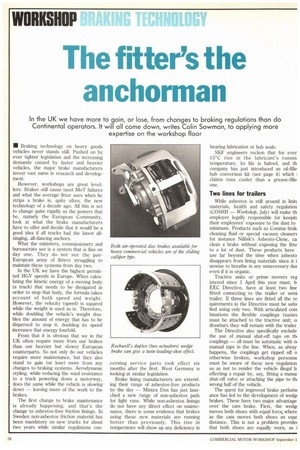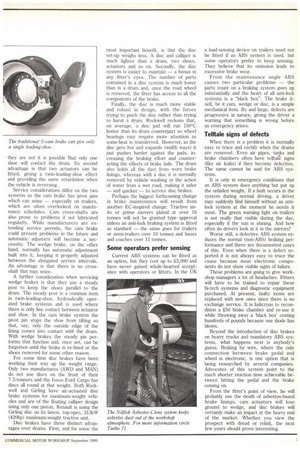The fitter's the anchorman
Page 120

Page 121

If you've noticed an error in this article please click here to report it so we can fix it.
• Braking technology on heavy goods vehicles never stands still. Pushed on by ever tighter legislation and the increasing demands caused by faster and heavier vehicles, the major brake manufacturers invest vast sums in research and development.
However, workshops are great levellers. Brakes still cause most MoT failures and what the average fitter sees when he strips a brake is, quite often, the new technology of a decade ago. All this is set to change quite rapidly as the powers that be, namely the European Community, look at what the brake manufacturers have to offer and decide that it would be a good idea if all trucks had the latest allsinging, all-dancing anchors.
What the ministers, commissioners and bureaucrats see is a system that is fine on day one. They do not see the panEuropean army of fitters struggling to maintain these systems from day two.
In the UK we have the highest permitted HGV speeds in Europe. When calculating the kinetic energy of a moving body (a truck) that needs to be dissipated in order to stop that body, the formula takes account of both speed and weight. However, the velocity (speed) is squared while the weight is used as is. Therefore, while doubling the vehicle's weight doubles the amount of energy that has to be dispersed to stop it, doubling its speed increases that energy fourfold.
From that it is obvious that we in the UK often require more from our brakes than our heavier but slower European counterparts. So not only do our vehicles require more maintenance, but they also stand to gain (or lose) more from any changes to braking systems. Aerodynamic styling, while reducing the wind resistance to a truck powering down a motorway, does the same while the vehicle is slowing down — leaving more of the work to the brakes.
The first change to brake maintenance is already happening, and that's the change to asbestos-free friction linings. In Sweden non-asbestos friction material has been mandatory on new trucks for about two years while similar regulations con cerning service parts took effect six months after the first. West Germany is looking at similar legislation.
Brake lining manufacturers are extending their range of asbestos-free products by the day — Mintex Don has just launched a new range of non-asbestos pads for light vans. While non-asbestos linings do not have any direct effect on maintenance, there is some evidence that brakes using these new materials are running hotter than previously. This rise in temperature will show up any deficiency in bearing lubrication or hub seals.
SKF engineers reckon that for ever 15°C rise in the lubricant's runnin temperature, its life is halved, and th company has just introduced an oil-fille, hub conversion kit (see page 4) which claims runs cooler than a grease-fille one.
Two lines for trailers
While asbestos is still around in linin materials, health and safety regulation (COSHH — Workshop, July) will make di, employer legally responsible for keepin their employees' exposure to the dust to minimum. Products such as Comma brak, cleaning fluid or special vacuum cleaners for instance Nilfisk's Asbesto-Clene, ca clean a brake without exposing the fitte to a lot of dust. These products have use far beyond the time when asbesto disappears from lining materials since it i unwise to breathe in any unnecessary dus even if it is organic.
Tractive units or prime movers reg istered since 1 April this year must, b. EEC Directive, have at least two line fitted connecting to the trailer or semi trailer. If three lines are fitted all the re quirements in the Directive must be satis fled using only two. With articulated com binations the flexible couplings (suzies must be attached to the tractive unit; oi drawbars they will remain with the trailer, The Directive also specifically exclude the use of manual shut-off taps on th• couplings — all must be automatic with no manual taps in the line. When, as alway happens, the couplings get ripped off o otherwise broken, workshop personne must be aware of these new regulation so as not to render the vehicle illegal b: effecting a repair by, say, fitting a mantu shut-off valve or attaching the pipe to di' wrong half of the vehicle.
The quest for improved brake perform ance has led to the development of wedg brakes. These have two major advantage over the cam brake. First, the wedg moves both shoes with equal force where as the cam moves both shoes an equz distance. This is not a problem provide' that both shoes are equally worn, as i they are not it is possible that only one shoe will contact the drum. Its second advantage is that two actuators can be fitted, giving a twin-leading-shoe effect and providing the same retardation when the vehicle is reversing.
Service considerations differ on the two systems as the cam brake has pivot pins which can seize — especially on trailers, which are often overlooked on maintenance schedules. Cam cross-shafts are also prone to problems if not lubricated regularly. While manufacturers are extending service periods, the cam brake could present problems in the future and automatic adjusters will become a neccessity. The wedge brake, on the other hand, normally has automatic adjustment built into it, keeping it properly adjusted between the elongated service intervals. An advantage is that there is no crossshaft that may seize.
A further consideration when servicing wedge brakes is that they use a steady post to keep the shoes parallel to the drum. The steady post is a common item in twin-leading-shoe, hydraulically operated brake systems and is used where there is only line contact between actuator and shoe. In the cam brake system the pivot pin stops the shoe from tilting so that, say, only the outside edge of the lining comes into contact with the drum. With wedge brakes the steady pin performs that function and, once set, can be forgotten until the brake is re-lined or the shoes removed for some other reason.
For some time disc brakes have been working their way up the weight range. Only two manufactures (AWE) and MAN) do not use discs on the front of their 7.5-tonners and the Iveco Ford Cargo has discs all round at that weight. Both Rockwell and Girling have air-actuated disc brake systems for maximum-weight vehicles and are of the floating calliper design using only one piston, Renault is using the Girling disc on its latest, top-spec, 313kW (420hp) maximum-weight tractive unit.
Disc brakes have three distinct advantages over drums. First, and for some the most important benefit, is that the disc set-up weighs less. A disc and calliper is much lighter than a drum, two shoes, actuators and so on. Secondly, the disc system is easier to maintain — a bonus in any fitter's eyes. The number of parts contained in a disc system is much lower than in a drum and, once the road wheel is removed, the fitter has access to all the components of the brake.
Finally, the disc is much more stable and robust in design, with the forces trying to pinch the disc rather than trying to burst a drum. Rockwell reckons that, on average, a disc pad will run 150°C hotter than its drum counterpart so wheel bearings may require more attention as some heat is transferred. However, as the disc gets hot and expands (width ways) it just pushes harder against the pads, increasing the braking effort and counteracting the effects of brake fade. The drum also holds all the dust from worn brake linings, whereas with a disc it is normally removed by vehicle washing or the action of water from a wet road, making it safer — and quicker — to service disc brakes.
Perhaps the biggest forthcoming change in brake maintenance will result from another EC-inspired change. Tractive units or prime movers plated at over 16 tonnes will not be granted type approval unless an anti-lock braking system is fitted as standard — the same goes for trailers or semi-trailers over 10 tonnes and buses and coaches over 12 tonnes.
Some operators prefer sensing
Current ABS systems can be fitted as an option, but they cost up to £3,000 and have never gained whole-hearted acceptance with operators or fitters. In the UK a load-sensing device on trailers need not be fitted if an ABS system is used, but some operators prefer to keep sensing. They believe that its omission leads to excessive brake wear.
From the maintenance angle ABS causes two particular problems — the parts count on a braking system goes up substantially and the heart of all anti-lock systems is a "black box". The brake itself, be it cam, wedge or disc, is a simple mechanical item. By and large, defects are progressive in nature, giving the driver a warning that something is wrong before an emergency arises.
Telltale signs of defects
When there is a problem it is normally easy to trace and rectify when the drums are removed. Even air pipes, tanks and brake chambers often have telltale signs (like air leaks) if they become defective. The same cannot be said for ABS systems.
It is only in emergency conditions that an ABS system does anything but put up the unladen weight. If a fault occurs in the system during normal driving, a driver may suddenly find himself without an antilock system at the moment he needs it most. The green warning light on trailers is not really that visible during the day, especially if the sun is shining. And how often do drivers look at it in the mirrors?
Worse still, a defective ABS system reduces the normal (non-ABS) braking performance and there are documented cases of this. Even when there is a defect reported it is not always easy to trace the cause because most electronic components do not show visible signs of failure.
These problems are going to give workshop managers a lot of headaches. Fitters will have to be trained to repair these hi-tech systems and diagnostic equipment purchased. At present, faulty items are replaced with new ones since there is no exchange service. It is ludicrous to recondition a £50 brake chamber and re-use it while throwing away a 'black box' costing hundreds of pounds because one diode has blown.
Beyond the introduction of disc brakes on heavy trucks and mandatory ABS systems, what happens next is anybody's guess. Braking by wire, where the only connection between brake pedal and wheel is electronic, is one option that is being researched by several companies. Advocates of this system point to the much shorter reaction time achievable between hitting the pedal and the brake coming on.
From the fitter's point of view, he will probably see the death of asbestos-based brake linings, cam actuators will lose ground to wedge, and disc brakes will certainly make an impact at the heavy end of the market. Whether you view the prospect with dread or relish, the next few years should prove interesting.
































































































































